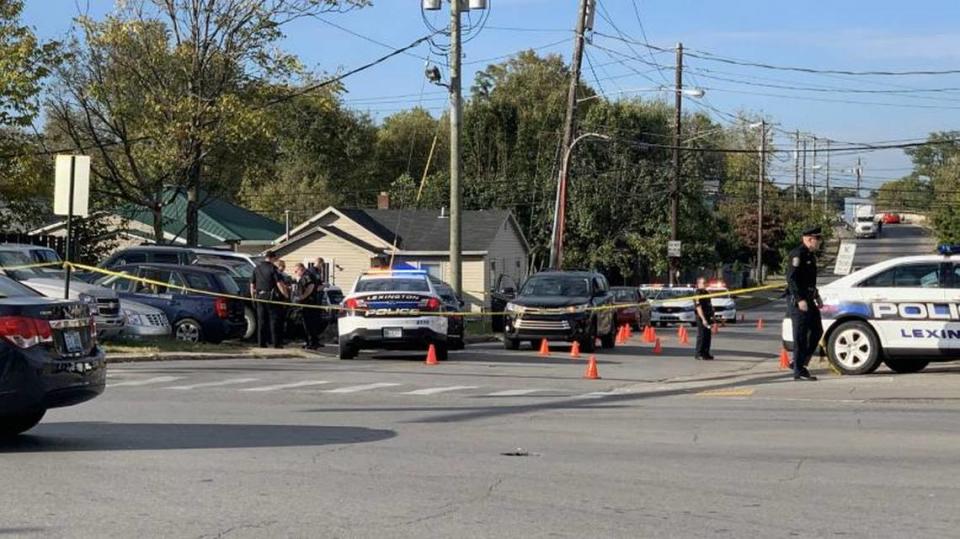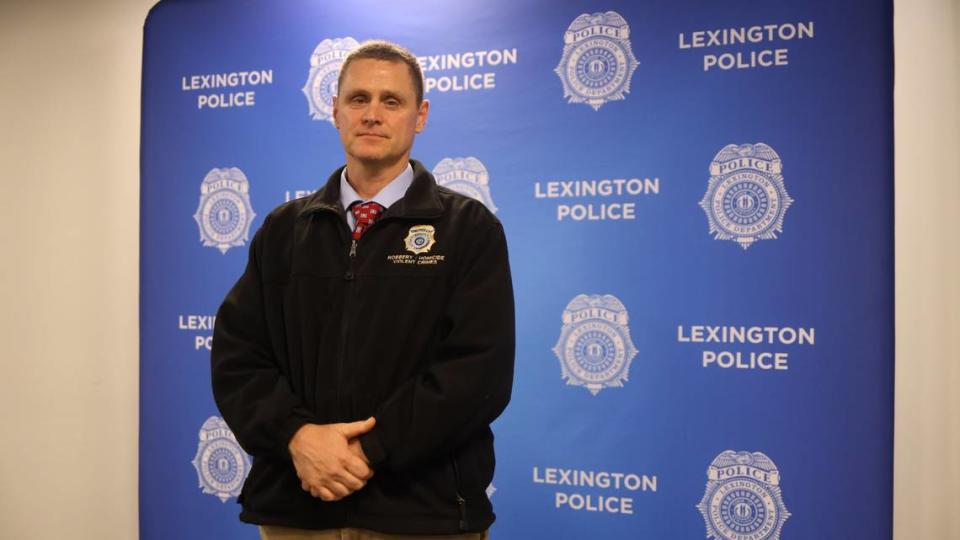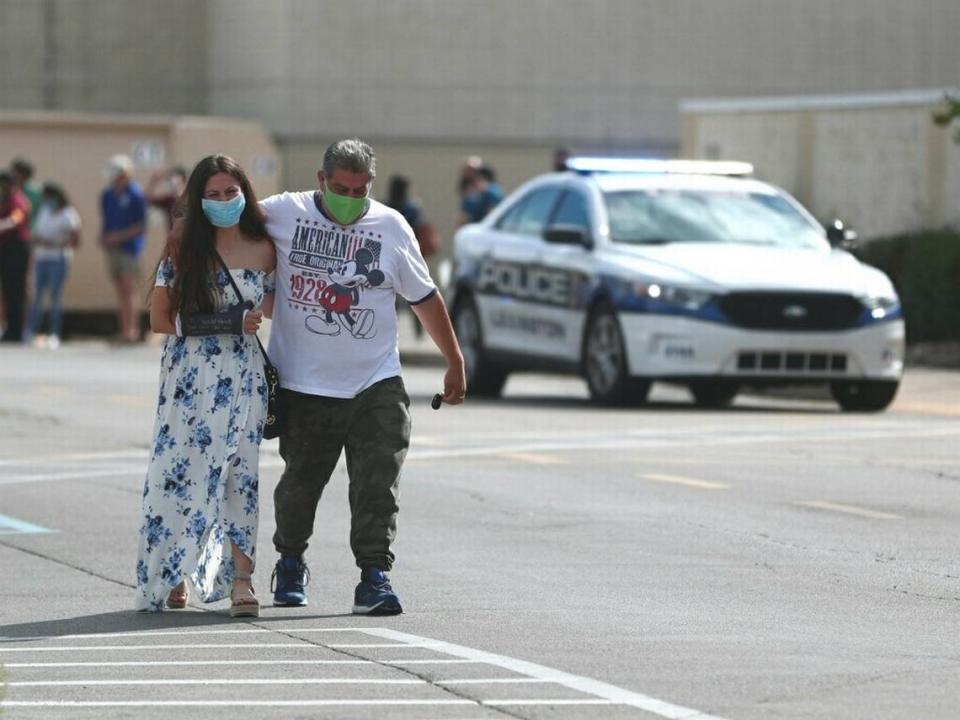‘They’re dead now.’ Are gang members, retaliations driving Lexington’s violent crime?
At least 37 gunshots rang out in a busy Lexington intersection, killing two and wounding a third, on the afternoon of Oct.19, 2019. The retaliation shooting was planned and executed by a gang, prosecutors say.
That gang is at the center of a separate and uncommon court case accusing 14 men between the ages of 17 and 31 of engaging in a criminal syndicate, namely, the East Side Gang, and a subgroup, the 530 gang, according to court records. The men are charged in other intertwining cases.
In the last few years, multiple shootings have been tied to gang members and gang activity. Court records filed by prosecutors and Lexington police reveal some connections between Lexington homicides and alleged gangs even though authorities have previously been reluctant to blame gangs publicly for the violence.
The 2019 shooting, which happened in broad daylight at the intersection of Winchester Road and Seventh Street, involved 530 gang members who were given guns and instructed to retaliate against the victims — alleged members of a rival group — who had spoken ill of a dead gang member.
After the shooting, the guns used were disassembled by gang members, cleaned and shipped out of state, prosecutors wrote in court documents.
The Winchester Road victims were two of a record 30 homicides in Lexington in 2019. The city set another record in 2020 with 34. There have been 22 so far this year, according to police data. There have also been 67 firearm assaults this year.
Retaliatory shootings between groups are not unusual, prosecutors have said in court records.
“In the past eighteen months, several shootings and homicides that have occurred in Lexington involved gang activity and retaliation between gang members,” according to a memorandum filed in October in Fayette Circuit Court by the Office of Fayette Commonwealth’s Attorney Lou Anna Red Corn.
“To be more specific, when an individual has been shot or killed, the victims’ friends or gang associates have retaliated by shooting other involved persons or friends of the victim. On several occasions, stray bullets fired by gang members have killed innocent bystanders and uninvolved parties.”
A “significant number” of victims and perpetrators in Lexington’s shootings are “affiliated with ... groups and gangs,” said Lt. Paul Boyles, who oversees homicide investigations. Some Lexington gang members are affiliated with others in Detroit, Chicago or nearby counties, Boyles said.
Rev. Joseph Owens, the pastor at Shiloh Baptist Church, has presided over the funerals of young men killed in Lexington and sees the extent and toll of gang and retaliatory violence.
“It’s pretty obvious when there’s one homicide, and there’s multiple people involved with others — many of them within blocks of each other,” Owens said. “ … I mean families have had multiple children in the same family who are known to be involved with different groups – they’re dead now.”
Some Lexington community members say it’s common to see people who were close with a homicide victim want to get back at whoever they think committed the killing. And they often have the means to do so.
“All the kids are carrying,” said Andre Maxberry, who has lost two young family members to violence since last summer. And if members of one group kill someone, “you best believe the people in that other group are going to come back somehow.”

Gangs make cases harder to prosecute
At the same time they fuel violence, gangs make homicides and other crimes harder to solve and prosecute. The threat, perceived or real, that witnesses to shootings could be targeted for talking has made some witnesses reluctant to cooperate.
Multiple gang members can be involved in multiple separate cases in different, conflicting ways.
“It’s terribly complicated because we have individuals who are charged, we have individuals who are witnesses, individuals who are victims, and that all crosses over,” Red Corn said in a July interview. “A person can be a victim in one case, a witness in another case and a defendant in another, but once they’re a defendant, they have those greater protections, so we have to go through their attorney to talk to them.
“They may or may not want to come to court because they have pending charges, so it certainly does complicate the prosecution of the case they’re charged with when there’s so much overlap.”
The prosecutor’s office coordinates with Lexington police, specifically the department’s intelligence unit, to identify people involved in the various gangs and gang cliques, Red Corn said.
But shifting alliances — and clashes — within gangs and among gang members challenge investigators trying to sort out who did what to whom.
“You’ll see what you think is a East or West or North Side Gang; suddenly, you’ll start seeing people from across those lines affiliated with others or falling out with others,” Boyles said.

Fayette uses syndicate charge to fight gangs
For the first time since 2018 changes to a state law, a different tool is being used to fight gang crime and violence. The criminal syndicate case has been filed in Lexington against 14 alleged gang members.
The defendants in the case have additional separate charges, ranging from murder and wanton endangerment to robbery and drug trafficking. There are also burglary, carfentanil trafficking and receiving stolen property charges.
The criminal syndicate defendants are accused of being involved in the East Side Gang, the alliance that includes the 530 gang, according to court records. The alleged criminal gang activity happened between September of 2017 and November 2020.
Those charged are accused of facilitating or directing the gang activity or committing or conspiring to commit acts of violence, theft or drug trafficking in support of the gang, according to the indictment.
Three of the four — John Boulder IV, Kenneth Jackson and Sevion Mitchell — charged in Winchester Road slayings of Dwayne Slaughter and Darrian Webb, both 18, are also charged in the syndicate case.
Boulder was also charged in a Dec. 10, 2019, Osage Court robbery that ended in a shooting that killed 23-year-old Damontrial D. Fulgham. Two others charged in Fulgham’s death — Jo’Qwan Jackson and Javari Butler — are also criminal syndicate case defendants.
The people involved in the Fulgham robbery-turned-homicide are also accused in another robbery on the same night during which a person was shot in the leg, according to court records.
Another charged in the syndicate case, Zacchaeus Smith, is also charged in an injury shooting that endangered other people in homes that were in the line of fire, according to court records.
The charge these 14 defendants face is a Class B felony, according to state law, unless it only involves stealing or illegally acquiring merchandise for resale, which would be a Class C felony. A Class B felony is punishable by 10 to 20 years in prison, according to state law.
Drugs, guns and car chases
Court cases for some of the young men accused in the crime syndicate included allegations of comprehensive drug trafficking enterprises and indicated that some suspects were armed and willing to go to great lengths to avoid apprehension.
Laybron Franklin, a 25-year-old charged in the criminal syndicate case, allegedly drove through a playground and over a staircase on Sept. 17 as police blocked off his street, leaving him nowhere to go but off-road. Lexington police detectives and officers were preparing to arrest Franklin on outstanding warrants for allegedly possessing a gun illegally and driving without a license.
Outfitted with police “raid vests,” officials yelled at Franklin to get out of the car, according to the arrest warrant. After his alleged high-speed, off-road getaway, Franklin nearly T-boned two detectives in another vehicle before he got back onto a road at Centre Parkway and fled, according to court records.
Family, fear, ‘a sense of belonging.’ What pushes Lexington teens toward gangs?
Police again encountered Franklin on Sept. 25 while surveilling him for “a violent crime and narcotics” investigation, according to court records. He allegedly tried to flee police again but was later detained.
Robert Michael Jackson, another defendant charged with participating in the criminal syndicate, was detained on Jan. 22, 2020, after a Fayette district judge signed off on a warrant for police to search an apartment in the 3600 block of Tates Creek Road.
The warrant followed a weeks-long investigation that used drug sales and a confidential informant.
Police found suspected heroin and marijuana in the apartment, along with ammunition and multiple guns: a .357-caliber Glock, a stolen.22-caliber Ruger, a .40-caliber Taurus and a “MicroRoni,” according to court records.
A Micro-Roni is a tool designed to give a pistol “greater effective range, faster aiming and better accuracy,” according to the product’s website.
Inside the apartment were Jackson and Alyssa Dawn Rader, according to arrest citations. Both were charged with drug trafficking, drug possession, drug paraphernalia possession and receiving a stolen gun.

Brazen shootings, exchanges of gunfire in public
The fighting between groups or gang members sometimes spills over into public spaces in broad daylight where bystanders are exposed. The brazen shooting on Winchester Road took place at the stoplight of the busy intersection with Seventh Street near downtown. The victims were in a passenger car; the alleged shooters were in an SUV.
In August 2020, shots were fired inside the Fayette Mall. Kenneth Bottoms Jr. – who was known by Lexington detectives to be a “validated” gang member – was killed and two other bystanders were wounded.
In addition to shootings with direct and confirmed ties to gangs, there have been exchanges of gunfire during daylight hours between groups of people.

In January, dozens of shots were fired between two vehicles in the afternoon on Tates Creek Road near Rockbridge Road, striking multiple homes and causing one vehicle driven by a bystander to flip. Some of the shootings have injured and killed bystanders, like 82-year-old grandmother Alice Carter who was killed in an exchange of gunfire between vehicles on Fifth Street in October.
Red Corn acknowledged that it seems like those types of public shootings are becoming more frequent. But not all are gang related, she said.
“I’ve been in this office for 35 years, and I can never remember a time when we had two shootings in our alley within a month of each other,” Red Corn said, referring to her office.
The shootings are due, in part, to the fact that people are mobile and that a lot of them are armed, Red Corn said. If there is a disagreement or disrespect, violence can erupt wherever those people happen to be at the same time.
It is believed a “very small group” is responsible for much of the violence in Lexington, and investigators are working to identify and stop them. Arrests are key but working on prevention and intervention initiatives will pay off in the long run, Red Corn said.
“I know it doesn’t feel good for people, it doesn’t feel good for me. I live here, I’m like everybody else,” Red Corn said. “If I hear that there’s been a shooting in the mall parking lot in the middle of the day, that’s frightening. And it’s hard to give people comfort by saying if you compare us to other cities, we’re so much safer. But that is true. And that is cold comfort, I guess, to say that.”
People who can help stop gangs are often afraid to talk
Violence and fear stop some witnesses from helping police and prosecutors.
Maxberry, the grandmother, said she’s talked to younger men who don’t feel comfortable going to the police because it can leave them at risk of retaliation.
“They’re afraid because the police are putting their names on paperwork that they’re able to see or get a hold of,” she said. “So that puts their families in danger.”
Acknowledging witnesses’ “huge reluctance,” Red Corn said her office has to balance protecting the accused’s rights with trying to prevent witnesses from being identified publicly or intimidated by suspects or their affiliates, she said. In criminal cases, the defendants have a right to be informed of the evidence against them, including potential witnesses and what they saw.
“We are trying to make sure that people who commit violent crimes are accountable and that witnesses feel safe to come forward in court,” Red Corn said.
Twelve of Lexington’s 22 homicides this year are still open investigations, according to police data. Seven cases from 2020 are still open and eight from 2019 are still open.

 Yahoo Finance
Yahoo Finance 